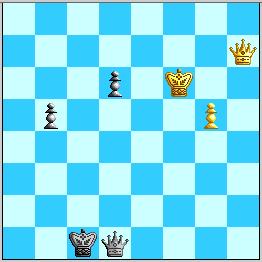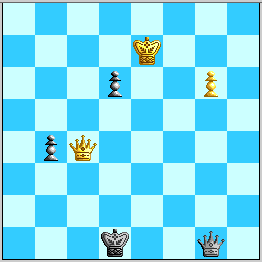
Diagram 1. Position with 52...Kc1.

Diagram 1. Position with 52...Kc1.
Here is the essence of the 52…Kc1 defense.
A. 53.Qc7+ Kb1, and now:
A1) 54.Qc6 Qd4+ 55.Kf5 Qe5+ 56.Kg4 b4, with equal chances.
A2) 54.Qe7 Qf3+ 55.Ke6 b4! 56.g6 Qg4+ 57.Kf7 Qf5+ 58.Qf6 Qd7+ 59.Kf8 Qc8+ 60.Ke7 b3 61.g7 b2, is equal.
A3) 54.Qc3 Qf1+, and now:
A31) 55.Ke7 Qg1! with:
A311) 56.Qd3+ Kc1 57.Qxb5 (57.g6 b4 transposes to Variation C242) 57…d5 (EGTB=; all three checks and Qg2/g4 also draw) 58.Qc6+ (58.Qxd5 is a theoretical draw) 58…Kb1 59.Qxd5 is a theoretical draw.
A312) 56.Qf6 b4 57.g6 b3 58.g7 b2, with equal chances.
A32) 55.Ke6 Qc4+ 56.Qxc4 bxc4 57.g6 c3 58.g7 c2 59.g8=Q c1=Q 60.Kxd6, draw.
A33) 55. Kg7 Qc4 56. Qe1+ Ka2 and it's just = as Black will achieve ...b3 before White gets his pawn to g7. Even careless play 57. Qf2+ Kb1?! 58. Qf5+ Ka2 (anwhere but ...Kb2? draws) 59. g6 b4 60. Kf8 b3 61. g7 b2 still holds comfortably.
A4) 54.g6 Qf3+ 55.Kg7 (if 55.Ke6 Qe4+, or 55.Ke7 Qe4+ 56.Kf7 Qf3+, equal) 55...b4 56.Qf7 Qc3+! 57.Kf8 Qh8+ 58.Ke7 Qe5+ 59.Kd7 Qb5+, is equal, for example:
A41) 60.Kxd6 Qd3+ 61.Ke5 (61.Kc6 Qa6+ 62.Kc5 Qa5+ 63.Kc4 Qa2+ 64.Kxb4 Qd2+! with a theoretical draw; 61.Kc7 Qg3+ 62.Kc6 b3 63.g7 Qc3+ 64.Kb5 Qd3+ 65.Ka4 Qa6+ 66.Kb4 Qb6+ 67.Kc4 Qa6+ 68.Kd4 Qb6+, is equal) 61...Qe3+ 62.Kf5 Qf3+ 63.Kg5 Qg3+ 64.Kh6 Qh4+ 65.Kg7 b3! and Black has equalized (White can take the pawn at the cost of yielding a theoretical draw).
A42) 60.Kc7 Qa5+ 61.Kb7 Qb5+ 62.Ka8 Qc6+ 63.Kb8 Qb6+, with a draw.
[Also good against 54. g6 is 54...Qd4+ 55. Kf7 Qd5+ 56. Kf8 Qa8+! 57. Kg7 b4=. This shows how unhelpful White's Queen on c7 is. Technically Black can also draw with 56...Qf5+?! 57. Qf7 Qc8+ as none of the entries for White playing Kxd6 in the row for Black's King on b1 (Table 2 of kingwalkegtbs.html) are winning for White. Note that with Black's King on b2, all of these entries are wins---this is why b2 is the "bogey square" in many lines! However, there was also nothing wrong with 53. Qc7+ Kb1, denying White the 54. Qc3 option and drawing similarly in the other lines.]
B. 53.g6 Qf3+ (53...Qd4+!? is also possible) 54.Ke7 Qb7+ (54...Qe4+, is also OK), with equal chances.
C. 53.Qe4 b4! (a key pawn sacrifice which we shall see again later in the story), and now:
C21) 54.Qc4+ Qc2, with:
C211) 55.Qxb4 Qf2+ 56.Kg7 d5,
C2111) 57.g6 d4 58.Qc4+ Kb2 59.Kg8 d3 60.g7 (60.Qxd3, is a theoretical draw; 60.Qb5+ Ka1 61.Qxd3, theoretical draw) 60...d2, equal.
C2112) 57.Qc3+ Kb1 58.Qb3+ Ka1 59.Qxd5, is a theoretical draw.
C212) 55.Qf1+ Qd1 56.Qf4+ Qd2 57.Qc4+ Qc2 58.Qxb4 Qf2+ 59.Kg7 d5, and now:
C2121) 60.g6 d4 61.Qc4+ Kb2 62.Kg8 d3 63.g7 (63.Qxd3, is a theoretical draw; 63.Qb5+ Ka1 64.Qxd3, is a theoretical draw) 63...d2, equal.
C2122) 60.Qc3+ Kb1 61.Qb3+ Ka1 62.Qxd5, is a theoretical draw.
C22) 54.Qxb4 (EGTB=) Qf3+! (but not 54...d5?? 55. Qf4+ +/-), and now:
C221) 55.Ke6 Qe3+! 56. Kf5 Qe5+! 57. Kg4 Qe2+! 58. Kg3 Qe3+ 59. Kh4 d5!, and as White has no checks and cannot advance his pawn, this is an immediate draw. At the time WT analysis gave the losing 55...d5? here, overlooking in C2212) below that after 56. Qc5+! Kb1 57. Qb6+! K-any 58. g6!, White's Queen indirectly protects the pawn! [The position after 57. Qb6+ is checkmate in 85 more moves. The "optimal" 57...Kc2 threads soon to a 5-piece win that would have been recognized by both sides after 58. g6 Qe4+ 59. Kf7 Qf5+ 60. Qf6 Qd7+ 61. Kf8 Qc8+ 62. Ke7 Qc7/b7+ (or 62...d4 63. Qxd4 EGTB+/- #79) 63. Ke6 Qb6+ (63...d4 64. Qxd4 ditto) 64. Ke5! Qe3+ 65. Kxd5 EGTB+/- #69---indeed, we've transposed to a key position from the Kasparov-Alterman analysis. However, the more challenging 57...Ka2! can be subdued only by the "Glorious Win" in the 58...Qf5 lines.] The correct path would have been seen soon enough as it is simple, but this goes to show how precarious Black is after 51...b5?! compared to the comfort of the 51...Ka1 draw.
C2211) 56.g6 d4 57.Qc5+ (if 57.Qxd4 Qb3+!! with a theoretical draw) 57...Qc3!
C22111) 58.Qg5+ Qe3+! 59.Qe5 (59.Qxe3+ dxe3 60.g7 e2 61.g8=Q e1=Q+, draw) 59...Qxe5+ 60.Kxe5 d3 61.g7 d2 62.g8=Q d1=Q, draw.
C22112) 58.Qxc3+ dxc3 59.g7 c2 60.g8=Q Kb1 61.Qg6 (61.Qb8+ Ka1, is a draw) 61...Ka1! and draw.
C2212) 56.Qc5+ Kb1 57.Qxd5, is a theoretical draw.
C222) 55.Kg7 d5! (only move) 56.g6 d4 57.Qxd4 with a theoretical draw, or 56. Qc5+ Kb1! (weirdly, 56...Kb2 draws only because Black can answer 57. Qd4+ with 57...Qc3!) 57. Qd4 Qe4! (only move), or 57. Qb6+ Ka2/c1/c2=. The key point compared to the later 58...Qf5 lines is that Black is up a tempo and always ready to answer g6 by the line-freeing sacrifice ...d4!
C23) 54.Qf4+ Qd2 55.Qxd2+ Kxd2 56.g6 b3 57.g7 b2 58.g8=Q b1=Q 59.Qd5+ Qd3 60.Qxd3+ Kxd3 61.Ke6, is a draw.
C24) 54.g6 Qf1+ 55.Ke7 (55. Ke6 is also included in notes below) Qg1 56.Qc4+ (56.Qc6+ Kb1 57.Qxd6 b3, with equal chances. Note also that 56. Kf7 is met by 56...Qf1+! to answer 57. Ke8 by 57...Qb5+ 58. Ke7 Qg5+ 59. Kf7 b3! 60. g7 b2 61. Qc4+ Kd2!=, or 60. Qc4+ Kb2 61. g7 Qf5+ 62. Ke7 Qe5+ 63. Kf8 Qf6+ 64. Kg8 Ka3=. Black can also hold by 56...Qf2+?! 57. Ke8! Qg3! (57...Qg1? 58. Qc4+ Kd1 59. Qf7! Qe3+ 60. Kf8 b3 61. g7 b2 62. Qf1+! Kc2 63. Qf5+! Kc1 64. g8=Q Qh6+ 65. Kf7+/-), but it is less comfortable after 58. Qc4+ Qc3! 59. Qf1+ Kb2 60. Qg2+ Ka3 61. g7 Qc8+! 62. Ke7 Qc7+ 63. Kf6 Qc3+ 64. Kg6 Qd3+ 65. Kg5 Qe3+ 66. Kg4 Qe6+ 67. Kg3 Qe5+!, or 60. Qf2+ Kc1!) 56...Kd1, and now:

Diagram 2, White to play. Black is still on the 1st rank but White cannot take advantage; Black is OK in the pawn race.
C241) 57.Kf7 Qf2+ 58.Kg8 Qc5 59.Qg4+ (59.Qxc5 dxc5 60.g7 b3 61.Kf7 b2 62.g8=Q b1=Q 63.Qg1+ Kc2 64.Qxc5+, draw) 59...Kc2 60.g7 b3 61.Kh7 b2, equal.
C242) 57.Qd3+ Kc1, and now:
C2421) 58.Kxd6 b3 59.Qc3+ Kb1 60.Qxb3+ Ka1! is a theoretical draw.
C2422) 58.Ke6 Kb2! 59.Kf7 (59.Kd5 b3 equalizes. Note then that 60.Kc4?? loses to 60...Qc5 mate! If 59.Kf6 Qf2+, with equal chances) 59...Qf2+ 60.Kg8 b3 61.g7 (61.Qxd6 Kc2 62.g7 b2, is equal) 61...Ka2 62.Qd5 (62.Qa6+ Kb1 63.Qxd6 b2, equal) 62...Qc5! 63.Qxc5 dxc5 64.Kh7 c4 65.g8Q c3! with a draw! [Also holding is 58...d5 59. Kxd5 EGTB=. At the time, I (KWR) thought Black had to thread a narrow path here with 59...Qg2+ 60. Kc4! Qf2! 61. Qd6! Kb1/b2! 62. Qxb4+=, but Karrer's EGTB tables show that Black has several other holding options. A third option for Black is 58...Qe1+, as 59. Kd5 Qe5+ 60. Kc4 d5+! 61. Kb3 Qb2+ 62. Ka4 Qf6! is just a draw.]
C2423) 58.Kf7/f8 Qf2+ 59.Ke8 (59.Ke7 Qg1 repeats) 59...Qe1+! [this move by Mobley may be vital, as 59...Qg1?! 60. Qc4+ Kd1 61. Qf7! is a situation where Black no longer has ...Qa7+, and then 61...Qe3+ 62. Kf8 b3 63. g7 b2 64. g8=Q b1=Q 65. Qf1+ wins for White as above] 60.Kd7 Qg1, with:
C24221) 61.Kxd6 b3 62.Qc3+ Kb1 63.Qxb3+ Ka1, and a theoretical draw.
C24222) 61.Ke7 Qa7+ 62.Kxd6 b3 63.Qc3+ Kb1 64.Qxb3+ Ka1! and a theoretical draw.
C24223) 61.Qc4+ Kd1! 62.Qe6 d5 63.Qxd5+ (EGTB=) Kc1/c2 64.Qc4+ Kb1 65.Qb3+ (65.Qxb4+ is a theoretical draw) 65…Ka1 66.Qa4+ Kb1 67.Qxb4+, with a theoretical draw.
D. 53.Qh6 Qd4+! 54.Ke6 (54.Kf7 Qd5+ 55.Ke7 Qb7+, equal) 54...Qe4+ 55.Kf6 Qf4+ 56.Ke7 Qe3+ 57.Kf7 Qa7+ 58.Kg8 Qb8+ 59.Qf8 Qxf8+ 60.Kxf8 b4 61.g6 b3 62.g7 b2 63.g8=Q b1=Q, a theoretical draw.
E. 53.Ke7 Qf3! 54.g6 Qb7+, transposes to Variation B.
F. 53.Qh4 Qf3+ 54.Ke6 d5 55.g6 (55.Qb4 Qe4+ 56.Qxe4 dxe4 57.g6 e3 58.g7 e2 59.g8=Q e1=Q+, with a theoretical draw) 55...Qe3+ 56.Kxd5 Qd3+, is equal.
G. 53.Qf5 Qd4+! 54.Kf7 b4 55.g6 b3 56.g7 (56.Qg5+ Qd2, with equal chances) 56...b2, and now:
G1) 57.Qg5+ Kc2! with equal chances.
G2) 57.Qf1+ Qd1 58.Qc4+ Qc2 59.Qf4+ Qd2 60.Qc4+ Qc2 61.Qxc2+ Kxc2 62.g8=Q b1=Q 63.Qg6+, draw.
G3) 57.g8=Q Qc4+ 58.Kf8 Qxg8+ 59.Kxg8 b1=Q 60.Qf4+, draw.